THE ULTIMATE GUIDE TO BUYING WEED SEEDS IN SOUTH AFRICA
Everything you need to know and more…
When buying cannabis seeds, we at Overgrow understand things can get a little confusing. You simply want to know how to (1) choose the right strain, (2) sow it in rich South African soil, (3) grow beautiful dagga plants and (4) enjoy the harvested bud’s medical and recreational benefits a couple of months later. Right?

You may be familiar with the cannabinoids THC and CBD, and terms like mother plant, indica, sativa and hybrid. But navigating the “information maze” can become overwhelming. Even experienced marijuana connoisseurs might not recognise weed lingo like feminised, auto-flowering, ruderalis genetics, terpenes, flavonoids, genotype, phenotype, and more.
There’s a massive selection of available cannabis varieties to pick from. So we’ve made things easier by giving you one comprehensive epicentre of information that will guide you to choose the best strain for your needs. Spoiler alert: There’s more than one path to finding the pot of gold at the end of the rainbow. Much will depend on your individual needs and preferences.
Genetics play a key role at every level, but you’ll see later that the environment is very important too. The first decision you need to make is what type of seeds you want to grow, then you can choose the best-fitting strain.
There’s a massive selection of available cannabis varieties to pick from. So we’ve made things easier by giving you one comprehensive epicentre of information that will guide you to choose the best strain for your needs. Spoiler alert: There’s more than one path to finding the pot of gold at the end of the rainbow. Much will depend on your individual needs and preferences.
Genetics play a key role at every level, but you’ll see later that the environment is very important too. The first decision you need to make is what type of seeds you want to grow, then you can choose the best-fitting strain.
IN THIS ARTICLE
Types of Weed Seeds Understanding Strain Categories All Things Growing Growing Cannabis in South Africa Current Legislation Breeding and GeneticsSTEP 1: CHOOSE YOUR PREFERRED SEED TYPE
Types of Weed Seeds
Cannabis seeds are organised into four main categories: Regular, Feminised, Autoflowering and CBD. There are pros and cons to each and also combinations like ‘Auto CBD’. Let’s dive deeper…
Regular seed packs come in a roughly 50/50 male/female split. It’s impossible to tell them apart until plants mature enough to start producing reproductive organs. They also offer obvious value for breeding purposes, if there are any advanced-level cultivators out there who wish to try their hand at creating an entirely new strain. Check out our regular catalogue.
On the downside, their life cycle is slower than that of auto varieties and some people can’t tolerate their high potency. Certain strains may require more effort, take longer to grow and some are far conspicuous (they’re big and super-smelly). From compact little indicas to whale-sized sativas. Browse our feminised options.
Different strains have varying THC:CBD ratios, anywhere from 1:1 to 1:2 to very high CBD options with almost no THC. Balanced ratios offer a very gentle, enjoyable effect. Ones with near-zero THC just about guarantee no “high” in even the biggest rookies and those with the lowest tolerance. You can buy ‘CBD Autos’ here too, which have added auto-flowering traits that make them smaller and faster.
The intoxicating effect of THC causes a drop in blood pressure that dilates the capillaries in your eyes, increasing blood flow and turning them red. This is why THC is effective at treating glaucoma.
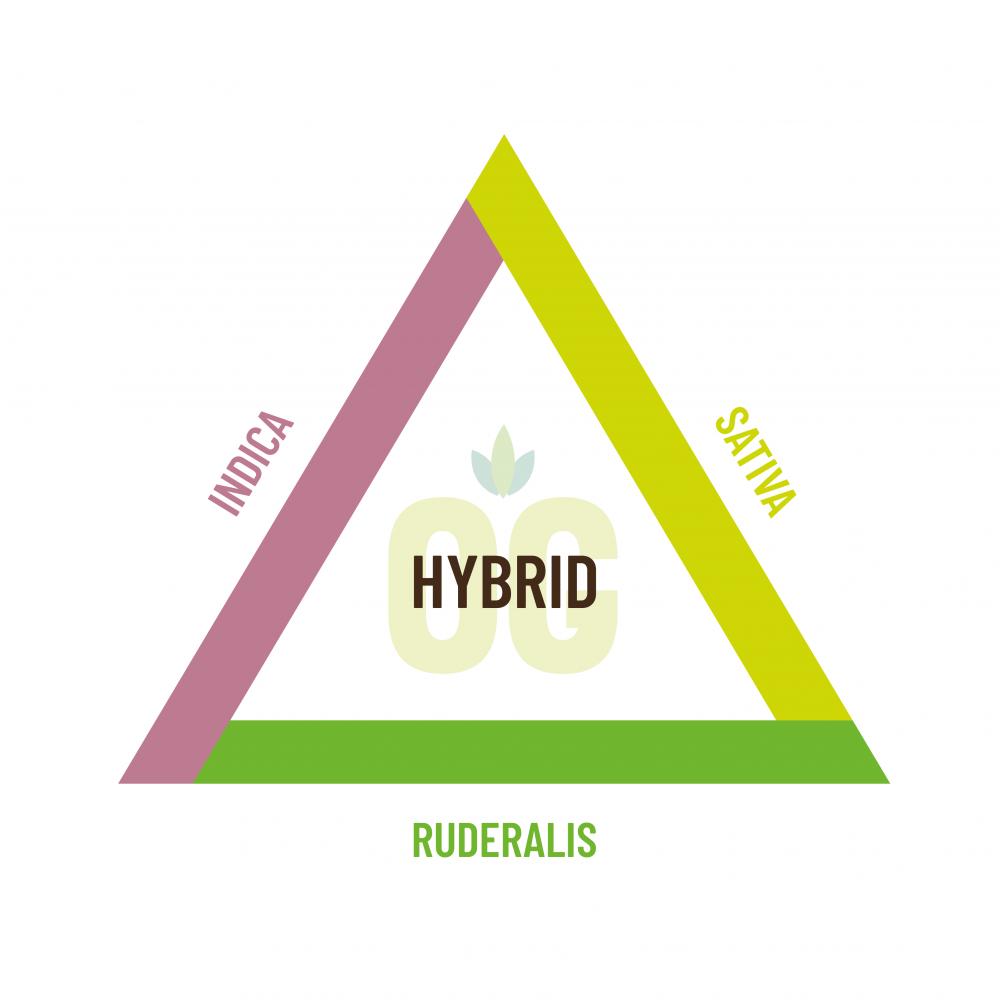
INDICA is more physically relaxing, better for inducing sleep or getting “couch-locked” with a good movie.
SATIVA gives an energising, uplifting, cerebral effect and is more suitable for social, physical and creative activities.
RUDERALIS is hardly familiar to any consumers, mostly because it’s not known for delivering a potent high.
HYBRIDS are bred to deliver any combination of the above, nicely balanced or leaning more one way or the other.
Popular weed culture feeds this “physical versus cerebral” belief, even though we now know that the varying effects are a little more complicated. In fact, if you conducted an experiment, asking 10 random smokers to try identify the strain in a ready-rolled joint. Chances are pretty good that some will guess right but some will get it wrong. Why is that? Because the effect is not based on the morphology of a plant or whether it’s more indica- versus sativa-dominant. The truth is that it has more to do with the complex interaction between an individual’s biochemistry and tolerance level, the consumption method used, and the unique chemical profile of the plant.
Range from the well-known, intoxicating THC (delta-9-tetrahydrocannabinol), highly-therapeutic CBD (cannabidiol) and sleep-promoting CBN (cannabinol), to raw forms like THCA (tetrahydrocannabinolic acid; decarboxylated to become THC), the very versatile, up-and-coming CBG (cannabigerol) and scarcely heard of THCV (tetrahydrocannabivarin).
Isolated for their seemingly endless therapeutic potential and sold as medicinal tinctures, topical balms, edibles, suppositories, etc.
Sometimes referred to in ratios, such as 1:1 THC-to-CBD.
Largely responsible for the treasured recreational and medical effects. But these compounds certainly can’t take all the credit.
Aromatic chemicals found throughout the plant kingdom (think lavender, wood, lemongrass, hops and pepper).
Each cannabis strain is made up of varying amounts of each to create an overall profile.
Each has its own organoleptic properties, combining to give strains their own unique flavours and aromas, but also affecting the psychoactive experience in ways we are still uncovering.
A few of the most common examples found in marijuana (along with their aromas) are: myrcene (spices, musk, earth, herbs), pinene (pine), caryophyllene (pepper, spices, wood), limonene (citrus), terpinolene (floral, pine, herbs), humulene (earth, hops, wood), linalool (lavender) and ocimene (sweet, herbs, wood).
20+ different varieties that interact with the above compounds and aid their effects.
Some connoisseurs prefer certain strain families based on these qualities, such as Skunk and Kush lineages. Over 100 different types of cannabinoids have been identified and the same figure applies to terpenes. Via a phenomenon known as the entourage effect, all of these plants compounds work together in unison, influencing one another to equip each strain with its own individual qualities (appearance, yield, smell, taste, effect, medical value, grow traits, etc.).
‘Sativa’ described non-intoxicating, European hemp plants that were used for their fibre and seeds.
‘Indica’ was the name given to an intoxicating form of marijuana discovered in the Hindu Kush Mountains.
‘Ruderalis’ is a wild breed thought to have originated in extreme northern climates. It deserves a special mention as its hardy genetics are used to add autoflowering traits and disease-resistance to plants, for growing in harsh outdoor conditions or discreet spaces.
In stark contrast to the highly-demanded modern hybrids, many connoisseurs and expert breeders seek the qualities of the oldest and purest genetics. Those that have existed for generations and have only been affected by wind, rain, sunshine and nature itself are known as heirloom strains. They’re generally not associated with commercial agriculture. A landrace strain simply describes one that was cultivated by humans, survived natural selection and has adapted to its present, traditional cannabis region over many years – named after the land on which it grows.
The difference between the two? Find out in Cannabis 101: How to Choose the Right Strain. You’ll also find mention of a few of our award-winning strain genetics. Our Lemon Thai Kush and Purple Afghan Kush options are not landraces but simply excellent-quality hybrids.
When it comes to the strain type, both are hybrids. Almost all strains are, nowadays. Gorilla is indica-dominant. Cheese CBD Auto is sativa-indica balanced, with a strong presence of autoflowering ruderalis genetics. The breeder in both these cases in Dinafem. See the image beside for another example.
A bit confusing? Don’t worry. It’s not exactly criminal to get mixed up sometimes (we’ll discuss more on legality later).
SATIVAS generally grow tall, skinny and love stretching out, with narrow leaves and lengthier flowering cycles. They’re better-equipped for longer growing seasons in warmer climates. Ideal for growing outdoors, due to their large size and open, aerated structure.
INDICAS usually grow short, solid and bushy, with wide leaves and a quicker flowering cycle. They’re well-suited for shorter growing seasons in cooler climates. More prone to moisture-related problems, due to their small, compact nature, although their small size is perfect for indoor cultivation.
Indicas are thought to be higher-yielding and coated more abundantly in resinous trichomes than their sativa cousins. However, this belief may be a little outdated because breeders like Dinafem and Humboldt thrive on breeding surprising and unexpected qualities into strains these days – manipulating properties like taste, smell, effect, size, flavour, colour and disease-resistance. A delightful kind of trickery, if you like. One of many examples is Blueberry Cookies, where exquisitely vibrant purple colours combine marvellously with decadent and fresh flavours.
Nowadays, it’s rare to find 100% pure indicas and sativas. The vast majority of your beloved dagga strains are, in fact, hybrids, created to combine favourable aspects of two “parents” into one outstanding offspring.
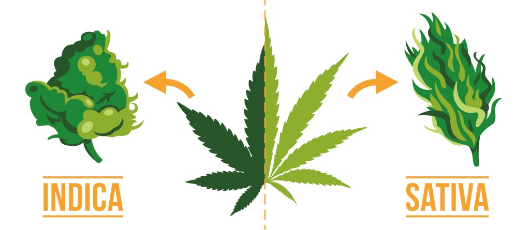
A little TLC goes a long way to getting the most out of your yield (in terms of both quality and quantity). No, that’s not a “THC” typo, it stands for ”tender loving care”, such as by pruning, getting watering and fertilisation just right, ensuring good air flow and lighting, keeping bugs at bay or, perhaps, using a SOG or SCROG method.
One easy way to decide where to grow is by assessing your available space. Do you have a small city terrace or nosy neighbours? Some dope smells potent but indica-dominant autos may fit discreetly. Is there enough space in your garage to grow the strain you’re after? You can always limit vegetative growth. Do you have time to build an indoor setup and sufficient cash to keep the electricity on?
You could add many more questions into the mix, like “Is there a sunny enough spot in your garden”, “Do you want to grow all year round?” and “Do you have access to plenty of open space for guerrilla growing?” There’s probably a business opportunity for a “grow coach” out there, but fortunately, you’ve got Overgrow to answer all your questions.
1. Regular Cannabis Seeds
These grow into both male and female plants, just as nature intended. They are best-suited to experienced growers who know how to “sex out” males. If grown together, females risk being pollinated by males to start producing seeds, taking essential energy away from creating succulent buds. For rookie growers, this risk can compromise the whole harvest.Regular seed packs come in a roughly 50/50 male/female split. It’s impossible to tell them apart until plants mature enough to start producing reproductive organs. They also offer obvious value for breeding purposes, if there are any advanced-level cultivators out there who wish to try their hand at creating an entirely new strain. Check out our regular catalogue.
2. Feminised Cannabis Seeds
Genetically altered to guarantee germination into females and not males. Bred with a focus on size, yielding-potential, fabulous flavours and aromas, but mostly for their high THC-content that delivers potent psychoactive effects (getting “high”). These strains are perfect for recreational de-stressing and relaxing or therapeutic use as an appetite-stimulating, pain-reliever, sleep-aid, muscle-relaxant, etc.On the downside, their life cycle is slower than that of auto varieties and some people can’t tolerate their high potency. Certain strains may require more effort, take longer to grow and some are far conspicuous (they’re big and super-smelly). From compact little indicas to whale-sized sativas. Browse our feminised options.
3. Autoflowering Cannabis Seeds
Easy-growing with a very fast, predetermined life cycle. Their Ruderalis genes aid speed and disease-resistance (less chance of pests and mold) and they’re better-suited to cooler climates with shorter summers. They begin to flower automatically after a set number of days (usually 21-30), regardless of the photoperiod (amount of light). “Autos” come in both THC- and CBD-rich varieties (the latter named “CBD Auto” marijuana seeds). Their simplicity makes them ideal for beginner growers, although they grow much smaller and don’t yield as highly as purely feminised varieties. Perfect for growing in limited indoor spaces or on a city terrace or balcony. Shop for autos now.4. CBD Cannabis Seeds
Selectively bred to produce flowers rich in cannabidiol – a highly therapeutic cannabinoid famed for its medicinal use. Evidence continues to mount for its ability to reduce symptoms like anxiety, inflammation, depression, muscle tension and insomnia. It’s progressively being used to support more complex conditions like drug-resistant epilepsy and multiple sclerosis.Different strains have varying THC:CBD ratios, anywhere from 1:1 to 1:2 to very high CBD options with almost no THC. Balanced ratios offer a very gentle, enjoyable effect. Ones with near-zero THC just about guarantee no “high” in even the biggest rookies and those with the lowest tolerance. You can buy ‘CBD Autos’ here too, which have added auto-flowering traits that make them smaller and faster.
Things to keep in mind when buying weed seeds:
- Breeders work hard at creating strain varieties that offer exceptions to the ”rules” laid out by their seed groupings (altering size, taste, smell, effect, disease-resistance, etc.).
- It’s important to note that all ‘Auto’ and ‘CBD’ versions are also feminised.
- As we’re after the coveted flowers produced by female plants, it’s commonplace (and not sexist) to refer to them by their feminine gender – lady, girl, queen, etc.
- It’s rare but possible that a seed in the pack won’t germinate. This is simply the norm anywhere in the world, so don’t get bent out of shape over it.
Dope Fact
Want to know why this lovely green herb turns you into a “red-eye Jedi”?The intoxicating effect of THC causes a drop in blood pressure that dilates the capillaries in your eyes, increasing blood flow and turning them red. This is why THC is effective at treating glaucoma.
STEP 2: PICK A STRAIN
Understanding Strain Categories
Indica, Sativa, Hybrid and Ruderalis
These are the four modern-day strain classifications. “Hemp” is just another word for low THC (below .03%) varieties, used for things like textile manufacturing, protein powders and animal feed. Anyone who knows anything about marijuana can tell you the difference between the first two, possibly three. It’s all about the effect, right? Maybe not. Here’s a simple explanation of what we expect from each:
INDICA is more physically relaxing, better for inducing sleep or getting “couch-locked” with a good movie.
SATIVA gives an energising, uplifting, cerebral effect and is more suitable for social, physical and creative activities.
RUDERALIS is hardly familiar to any consumers, mostly because it’s not known for delivering a potent high.
HYBRIDS are bred to deliver any combination of the above, nicely balanced or leaning more one way or the other.
Popular weed culture feeds this “physical versus cerebral” belief, even though we now know that the varying effects are a little more complicated. In fact, if you conducted an experiment, asking 10 random smokers to try identify the strain in a ready-rolled joint. Chances are pretty good that some will guess right but some will get it wrong. Why is that? Because the effect is not based on the morphology of a plant or whether it’s more indica- versus sativa-dominant. The truth is that it has more to do with the complex interaction between an individual’s biochemistry and tolerance level, the consumption method used, and the unique chemical profile of the plant.
Chemical Compounds Offering Unique Potential
Cannabinoids
Terpenes
Flavonoids
Some connoisseurs prefer certain strain families based on these qualities, such as Skunk and Kush lineages. Over 100 different types of cannabinoids have been identified and the same figure applies to terpenes. Via a phenomenon known as the entourage effect, all of these plants compounds work together in unison, influencing one another to equip each strain with its own individual qualities (appearance, yield, smell, taste, effect, medical value, grow traits, etc.).
So where do strain names come from?
Historically, the origins of all marijuana can be traced back to Central Asia. After all, it’s defined as “a tall Asian herb…” Cannabis is thought to have evolved somewhere between 6.38 and 34 million years ago and has been intertwined with human existence for many thousands of years. The names as we know them date back to the 1700’s, portraying the regions from where the plants originated.In stark contrast to the highly-demanded modern hybrids, many connoisseurs and expert breeders seek the qualities of the oldest and purest genetics. Those that have existed for generations and have only been affected by wind, rain, sunshine and nature itself are known as heirloom strains. They’re generally not associated with commercial agriculture. A landrace strain simply describes one that was cultivated by humans, survived natural selection and has adapted to its present, traditional cannabis region over many years – named after the land on which it grows.
The difference between the two? Find out in Cannabis 101: How to Choose the Right Strain. You’ll also find mention of a few of our award-winning strain genetics. Our Lemon Thai Kush and Purple Afghan Kush options are not landraces but simply excellent-quality hybrids.
Seed and Strain Terminology
Most people use “seeds” and “strains” interchangeably. Here’s the knowhow. ‘Gorilla’ is the name of a strain you’ll find in our ‘Feminised Seeds’ catalogue. Straightforward enough. Elsewhere, ‘Cheese CBD Auto’ is a strain name, where ‘CBD Auto’ also represents the seed type.When it comes to the strain type, both are hybrids. Almost all strains are, nowadays. Gorilla is indica-dominant. Cheese CBD Auto is sativa-indica balanced, with a strong presence of autoflowering ruderalis genetics. The breeder in both these cases in Dinafem. See the image beside for another example.
A bit confusing? Don’t worry. It’s not exactly criminal to get mixed up sometimes (we’ll discuss more on legality later).
STEP 3: GROW YOUR SEEDS
All Things Growing
Sativa Versus Indica Genetics
They don’t deliver the effect that mainstream culture tells us they do. So why bother with strain classification at all? Well, “highs” aside, the categories are very useful for growers.SATIVAS generally grow tall, skinny and love stretching out, with narrow leaves and lengthier flowering cycles. They’re better-equipped for longer growing seasons in warmer climates. Ideal for growing outdoors, due to their large size and open, aerated structure.
INDICAS usually grow short, solid and bushy, with wide leaves and a quicker flowering cycle. They’re well-suited for shorter growing seasons in cooler climates. More prone to moisture-related problems, due to their small, compact nature, although their small size is perfect for indoor cultivation.
Indicas are thought to be higher-yielding and coated more abundantly in resinous trichomes than their sativa cousins. However, this belief may be a little outdated because breeders like Dinafem and Humboldt thrive on breeding surprising and unexpected qualities into strains these days – manipulating properties like taste, smell, effect, size, flavour, colour and disease-resistance. A delightful kind of trickery, if you like. One of many examples is Blueberry Cookies, where exquisitely vibrant purple colours combine marvellously with decadent and fresh flavours.
Nowadays, it’s rare to find 100% pure indicas and sativas. The vast majority of your beloved dagga strains are, in fact, hybrids, created to combine favourable aspects of two “parents” into one outstanding offspring.

Indoor Versus Outdoor Cultivation
There are many unique factors to consider when choosing to grow indoors or outdoors, like climate, experience, space, time and finance.A little TLC goes a long way to getting the most out of your yield (in terms of both quality and quantity). No, that’s not a “THC” typo, it stands for ”tender loving care”, such as by pruning, getting watering and fertilisation just right, ensuring good air flow and lighting, keeping bugs at bay or, perhaps, using a SOG or SCROG method.
One easy way to decide where to grow is by assessing your available space. Do you have a small city terrace or nosy neighbours? Some dope smells potent but indica-dominant autos may fit discreetly. Is there enough space in your garage to grow the strain you’re after? You can always limit vegetative growth. Do you have time to build an indoor setup and sufficient cash to keep the electricity on?
You could add many more questions into the mix, like “Is there a sunny enough spot in your garden”, “Do you want to grow all year round?” and “Do you have access to plenty of open space for guerrilla growing?” There’s probably a business opportunity for a “grow coach” out there, but fortunately, you’ve got Overgrow to answer all your questions.
Growing Cannabis in South Africa
In SA, we’re blessed with a pretty warm and sunny climate, although our country is as diverse in climatic conditions as it is in people.
You generally want to avoid growing outdoors in winter and certain plants are better-suited to specific regions. For example, up near Johannesburg, you’ve got summer rainfall to contend with. Around Durban, there’s relentless 24/7 humidity. In Cape Town, the South-Easter will blow the precious trichomes off your buds and all the way up to the top of Table Mountain, if you’re not careful. Fortunately for us, we don’t have short summers and long winters, like they do in much of the US and Europe. So there are few places where you need to worry about extremely harsh conditions.
In humid regions, you don’t want compact indicas that are prone to mold and fungi. Growing in the Karoo, you’ll easily provide all the sunshine that plants need to thrive, but you’ll also need to be able to keep up with the watering and feeding schedules of giants like Moby Dick. If you’re growing on a balcony in Port Elizabeth and need discretion, autoflowering seeds are a great option. Use the outdoor growing calendar below as a guideline – click on it to download and print it off.
We have over 140 unique cannabis seeds in our catalogue. Even with all the knowledge we provide, you might ask yourself, “With so many options, how do I choose the right strain?” Truth is, there are probably several great alternatives to perfectly fit your growing needs. Once you’ve identified a few that you like, make sure you cover your bases. Read through each strain’s ‘morphology’, ‘yield’ and ‘cultivation’ to learn about the growth characteristics. Then, finding the perfect strain will come down to individual preferences like the flavour, aroma and psychoactive experience you desire.
Not sure where sure where to start or simply want to find out more on this topic? Read more on outdoor growing in SA. You could also build a greenhouse to extend the outdoor season and provide a cosy, protected habitat for your beloved dagga plants.
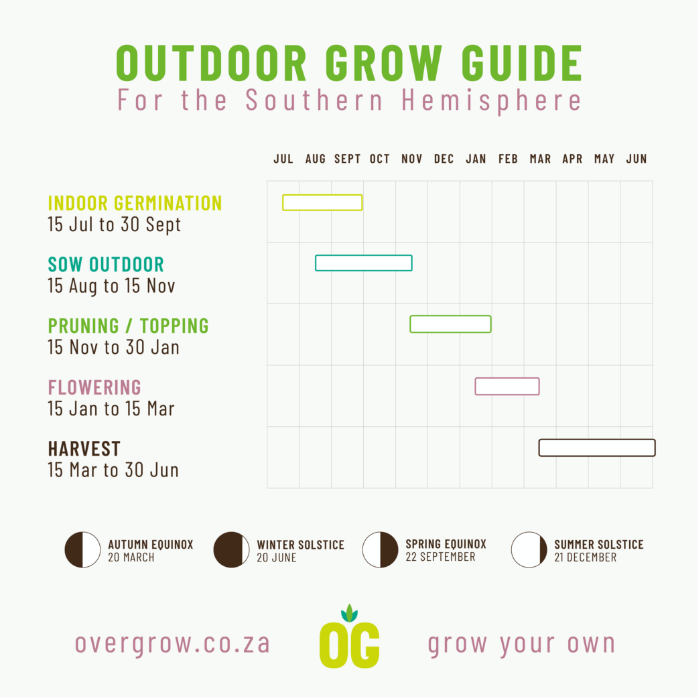
Though the contemporary categories as we know them appear here to stay.
You generally want to avoid growing outdoors in winter and certain plants are better-suited to specific regions. For example, up near Johannesburg, you’ve got summer rainfall to contend with. Around Durban, there’s relentless 24/7 humidity. In Cape Town, the South-Easter will blow the precious trichomes off your buds and all the way up to the top of Table Mountain, if you’re not careful. Fortunately for us, we don’t have short summers and long winters, like they do in much of the US and Europe. So there are few places where you need to worry about extremely harsh conditions.
In humid regions, you don’t want compact indicas that are prone to mold and fungi. Growing in the Karoo, you’ll easily provide all the sunshine that plants need to thrive, but you’ll also need to be able to keep up with the watering and feeding schedules of giants like Moby Dick. If you’re growing on a balcony in Port Elizabeth and need discretion, autoflowering seeds are a great option. Use the outdoor growing calendar below as a guideline – click on it to download and print it off.
We have over 140 unique cannabis seeds in our catalogue. Even with all the knowledge we provide, you might ask yourself, “With so many options, how do I choose the right strain?” Truth is, there are probably several great alternatives to perfectly fit your growing needs. Once you’ve identified a few that you like, make sure you cover your bases. Read through each strain’s ‘morphology’, ‘yield’ and ‘cultivation’ to learn about the growth characteristics. Then, finding the perfect strain will come down to individual preferences like the flavour, aroma and psychoactive experience you desire.
Not sure where sure where to start or simply want to find out more on this topic? Read more on outdoor growing in SA. You could also build a greenhouse to extend the outdoor season and provide a cosy, protected habitat for your beloved dagga plants.

Put this in your pipe and smoke it
To be completely accurate and in line with strict botanical definitions, ‘Cannabis sativa’ describes what we call “hemp” plants (low THC varieties) today, while ‘Cannabis indica’ is the classification used to describe both the modern-day “indicas” (Cannabis indica ssp. afghanica) and “sativas” (Cannabis indica ssp. indica).Though the contemporary categories as we know them appear here to stay.
Current Legislation
Current Legislation
In recent times, there’s been a rapid rise of marijuana decriminalisation for both medicinal and recreational purposes around the globe – notably in Canada, many US states, Spain, Uruguay and Mexico. It’s time for the question on everyone’s lips.
By decriminalising personal use and growing, the foundation has been set for future commercial and medicinal cannabis use in South Africa. But we’ll surely be waiting a while before that gets cleared up. One thing’s for sure, the laws need to be clarified and implemented sooner rather than later.
For now, the law only makes provision for growing and using dagga at home, but to do that you’ve got to get it somewhere first. At Overgrow, we take all the risk off your hands by bringing premium cannabis seeds in from overseas. You won’t get a letter from customs saying they “have something for you” and you need to “get in touch”. Your weed seeds remain untouched, in their original packaging and get delivered to your desired location in a discreet, unmarked envelope.
Is it legal to buy dagga seeds in South Africa?
The Supreme Court of South Africa decriminalised the private use and private cultivation of marijuana on Tuesday, 18 September 2018. This means that adults are allowed to use weed privately and grow it for their personal use. In August 2020, the legal limits were clarified. Read more on current legislation to find how many plants you may grow at home, how many seeds, flowers (grams) and plants you may possess in public, and what you’re allowed to share with friends.By decriminalising personal use and growing, the foundation has been set for future commercial and medicinal cannabis use in South Africa. But we’ll surely be waiting a while before that gets cleared up. One thing’s for sure, the laws need to be clarified and implemented sooner rather than later.
For now, the law only makes provision for growing and using dagga at home, but to do that you’ve got to get it somewhere first. At Overgrow, we take all the risk off your hands by bringing premium cannabis seeds in from overseas. You won’t get a letter from customs saying they “have something for you” and you need to “get in touch”. Your weed seeds remain untouched, in their original packaging and get delivered to your desired location in a discreet, unmarked envelope.
Breeding & Genetics
We stock only the best strains from some of the most reputable breeders in the world. Subscribe to our Newsletter to stay informed of new breeders and limited edition seeds drops. Check out our Breeder Guide for more detailed info.
They pride themselves on undertaking challenging breeding projects to produce a variety of elite strains, capable of meeting the personalised needs of all marijuana users and growers – from inexperienced to the most demanding experts.
Dinafem guarantee nothing but outstanding quality through their collection of premium genetics from around the globe. We stock everything from their famous Amnesia Kush to White Widow XXL Autoflowering.
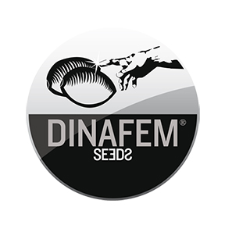
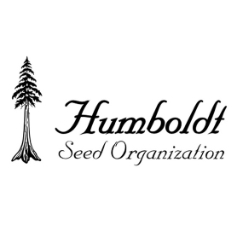
Humboldt County is a rough and hardly-touched stretch of Northern Californian coastline, particularly noted for its redwood forests – the largest trees in the world. This region has over 4500 outdoor weed gardens and many indoors too. It’s one “corner” of the famed Emerald Triangle – the largest producer of marijuana in the USA.
HSO pride themselves on using elite Californian genetics to deliver some of the most outstanding strains on the planet. We stock everything from their legendary OG Kush to Green Crack CBD and everything in between.
Harry Palms and Oni Noodles are the founders, who are not big on marketing and prefer for to allow their strain genetics to speak for themselves. Their goals are simple: premium-quality marijuana with bags of flavour and rich resin counts for making hashish.
With Oni, the focus is always quality over quantity. They meticulously fine-tune their selection process, narrowing multiple high-quality strains to one single strain of supreme genetic strength. We offer some of their elite flavour bombs.
GENOTYPE describes the genetic blueprint of a particular strain or what traits it has the potential to express. It’s the DNA, “the “nature” component.
PHENOTYPE describes the influence of environment on genetics to determine how plants actually do express themselves (appearance, size, resin, effect, etc). The “nurture” factor.

Ever heard the saying, “No two people are alike”? When it comes to growing marijuana, it could be said that “no two phenos are the same”. Different seeds from the same mother plant offer a slightly dissimilar genetic code, much like two siblings from the same human parents.
Think of it this way - if two siblings are born with different coloured eyes, it doesn’t mean their mother had an affair with the milkman. Seeds are just like siblings, they have slightly different genes. For example, human genes might code for brown versus green eyes. Cannabis genes might code for longer versus shorter internodal distance.
One DIY method to replicate desired genetics is to grow “mothers” and take cuttings to create clones. Two clones from the same mother plant will be “identical twins” and grow alike. Although these can still produce noticeably different bud and other traits, when raised in different circumstances.
Expert breeders spend years striving to stabilize and perfect strain genetics. Their aim is to reproduce favourable characteristics through seeds that deliver homogenous weed plants, time and time again.
Dinafem
A vastly-experienced Spanish seed bank and breeder. Famous for selling the most highly sought after cannabis seeds on the planet.They pride themselves on undertaking challenging breeding projects to produce a variety of elite strains, capable of meeting the personalised needs of all marijuana users and growers – from inexperienced to the most demanding experts.
Dinafem guarantee nothing but outstanding quality through their collection of premium genetics from around the globe. We stock everything from their famous Amnesia Kush to White Widow XXL Autoflowering.


Humboldt Seed Organization (HSO)
A world-renowned American breeder and seed bank with a very proud heritage steeped in environmental protection and cannabis tradition.Humboldt County is a rough and hardly-touched stretch of Northern Californian coastline, particularly noted for its redwood forests – the largest trees in the world. This region has over 4500 outdoor weed gardens and many indoors too. It’s one “corner” of the famed Emerald Triangle – the largest producer of marijuana in the USA.
HSO pride themselves on using elite Californian genetics to deliver some of the most outstanding strains on the planet. We stock everything from their legendary OG Kush to Green Crack CBD and everything in between.
Oni Seed Co
Oni Seed Co is a Californian breeder that provides some of the most wanted seeds around. They cater to an exclusive market, breeding artisanal or “craft cannabis” strains.Harry Palms and Oni Noodles are the founders, who are not big on marketing and prefer for to allow their strain genetics to speak for themselves. Their goals are simple: premium-quality marijuana with bags of flavour and rich resin counts for making hashish.
With Oni, the focus is always quality over quantity. They meticulously fine-tune their selection process, narrowing multiple high-quality strains to one single strain of supreme genetic strength. We offer some of their elite flavour bombs.
Why do genetics matter?
You will have noticed that genetics are deeply intertwined with every step of the decision-making process – choosing a seed type, identifying strains, and figuring out where and how to grow them. As is often the case when birthing something, the end result of a cannabis seed is a matter of “nature versus nurture”.GENOTYPE describes the genetic blueprint of a particular strain or what traits it has the potential to express. It’s the DNA, “the “nature” component.
PHENOTYPE describes the influence of environment on genetics to determine how plants actually do express themselves (appearance, size, resin, effect, etc). The “nurture” factor.
“Genetics and environment are equally important when cultivating marijuana.”

Ever heard the saying, “No two people are alike”? When it comes to growing marijuana, it could be said that “no two phenos are the same”. Different seeds from the same mother plant offer a slightly dissimilar genetic code, much like two siblings from the same human parents.
Think of it this way - if two siblings are born with different coloured eyes, it doesn’t mean their mother had an affair with the milkman. Seeds are just like siblings, they have slightly different genes. For example, human genes might code for brown versus green eyes. Cannabis genes might code for longer versus shorter internodal distance.
One DIY method to replicate desired genetics is to grow “mothers” and take cuttings to create clones. Two clones from the same mother plant will be “identical twins” and grow alike. Although these can still produce noticeably different bud and other traits, when raised in different circumstances.
Expert breeders spend years striving to stabilize and perfect strain genetics. Their aim is to reproduce favourable characteristics through seeds that deliver homogenous weed plants, time and time again.
LIBRARY
OUR LATEST ARTICLES
10 TOP TIPS TO GROW CANNABIS INDOORS

LOAD SHEDDING: THE REAL INDOOR GROWING PEST
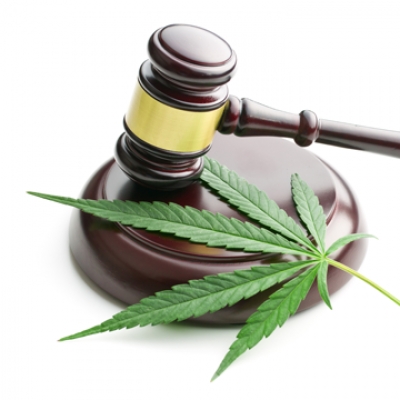
CANNABIS LAWS IN SOUTH AFRICA: CURRENT STATE OF PLAY
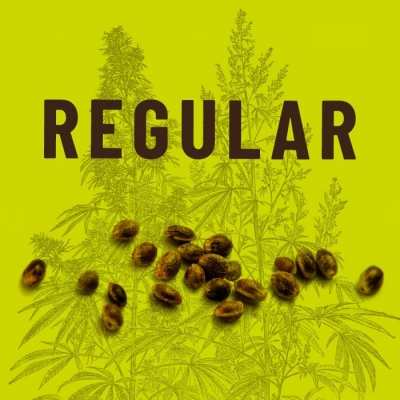
HOW TO GROW REGULAR CANNABIS SEEDS
FOLLOW OVERGROW
FOLLOW US ON INSTAGRAM
REVIEW US ON ASKMARYJ
MY CART
